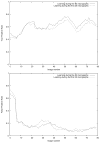Automatic particle selection from electron micrographs using machine learning techniques
- PMID: 19555764
- PMCID: PMC2777658
- DOI: 10.1016/j.jsb.2009.06.011
Automatic particle selection from electron micrographs using machine learning techniques
Abstract
The 3D reconstruction of biological specimens using Electron Microscopy is currently capable of achieving subnanometer resolution. Unfortunately, this goal requires gathering tens of thousands of projection images that are frequently selected manually from micrographs. In this paper we introduce a new automatic particle selection that learns from the user which particles are of interest. The training phase is semi-supervised so that the user can correct the algorithm during picking and specifically identify incorrectly picked particles. By treating such errors specially, the algorithm attempts to minimize the number of false positives. We show that our algorithm is able to produce datasets with fewer wrongly selected particles than previously reported methods. Another advantage is that we avoid the need for an initial reference volume from which to generate picking projections by instead learning which particles to pick from the user. This package has been made publicly available in the open-source package Xmipp.
Figures








Similar articles
-
Particle quality assessment and sorting for automatic and semiautomatic particle-picking techniques.J Struct Biol. 2013 Sep;183(3):342-353. doi: 10.1016/j.jsb.2013.07.015. Epub 2013 Aug 6. J Struct Biol. 2013. PMID: 23933392
-
A pattern matching approach to the automatic selection of particles from low-contrast electron micrographs.Bioinformatics. 2013 Oct 1;29(19):2460-8. doi: 10.1093/bioinformatics/btt429. Epub 2013 Aug 19. Bioinformatics. 2013. PMID: 23958728
-
APPLE picker: Automatic particle picking, a low-effort cryo-EM framework.J Struct Biol. 2018 Nov;204(2):215-227. doi: 10.1016/j.jsb.2018.08.012. Epub 2018 Aug 19. J Struct Biol. 2018. PMID: 30134153 Free PMC article.
-
Artificial intelligence in cryo-EM protein particle picking: recent advances and remaining challenges.Brief Bioinform. 2024 Nov 22;26(1):bbaf011. doi: 10.1093/bib/bbaf011. Brief Bioinform. 2024. PMID: 39820248 Free PMC article. Review.
-
Fundamentals of three-dimensional reconstruction from projections.Methods Enzymol. 2010;482:1-33. doi: 10.1016/S0076-6879(10)82001-4. Methods Enzymol. 2010. PMID: 20888956 Free PMC article. Review.
Cited by
-
Maskiton: Interactive, web-based classification of single-particle electron microscopy images.J Struct Biol. 2013 May;182(2):155-63. doi: 10.1016/j.jsb.2013.02.007. Epub 2013 Feb 18. J Struct Biol. 2013. PMID: 23428431 Free PMC article.
-
Deep Consensus, a deep learning-based approach for particle pruning in cryo-electron microscopy.IUCrJ. 2018 Oct 30;5(Pt 6):854-865. doi: 10.1107/S2052252518014392. eCollection 2018 Nov 1. IUCrJ. 2018. PMID: 30443369 Free PMC article.
-
Robustness of signal detection in cryo-electron microscopy via a bi-objective-function approach.BMC Bioinformatics. 2019 Apr 3;20(1):169. doi: 10.1186/s12859-019-2714-8. BMC Bioinformatics. 2019. PMID: 30943890 Free PMC article.
-
Assisted protein folding at low temperature: evolutionary adaptation of the Antarctic fish chaperonin CCT and its client proteins.Biol Open. 2014 Apr 15;3(4):261-70. doi: 10.1242/bio.20147427. Biol Open. 2014. PMID: 24659247 Free PMC article.
-
A clarification of the terms used in comparing semi-automated particle selection algorithms in cryo-EM.J Struct Biol. 2011 Sep;175(3):348-52. doi: 10.1016/j.jsb.2011.03.009. Epub 2011 Mar 21. J Struct Biol. 2011. PMID: 21420497 Free PMC article.
References
-
- Chong CW, Raveendran P, Mukundan R. Translation invariants of zernike moments. Pattern recognition. 2003;36:1765–1773.
-
- Efron B, Tibshirani R. An introduction to the bootstrap. Chapman & Hall; Boca Raton, Florida, USA: 1993.
-
- Freund Y, Schapire RE. Experiments with a new boosting algorithm. Proc. Intl. Work-shop of Machine Learning; 1996. pp. 148–156.
-
- Hall RJ, Patwardhan A. A two step approach for semi-automated particle selection from low contrast cryo-electron micrographs. J Structural Biology. 2004;145:19–28. - PubMed
-
- Hand DJ, Yu K. Idiot’s bayes - not so stupid after all? Intl Statistical Review. 2001;69:385–399.
Publication types
MeSH terms
Substances
Grants and funding
LinkOut - more resources
Full Text Sources

